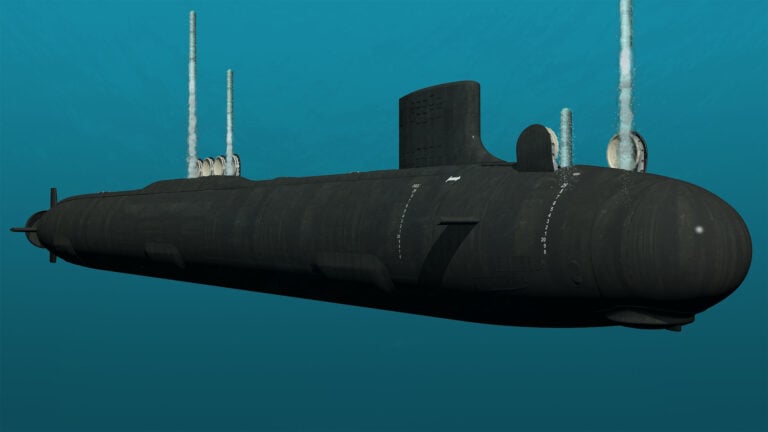
THE PENTAGON – The Navy’s Fiscal Year 2025 budget will ask Congress to fund one Virginia-class attack boat, a break from a steady two-per-year demand signal from the service and a sign that industry is still catching up to the current demand, three sources familiar with the proposed budget submission confirmed to USNI News.
While the Navy plans to only ask for one Virginia attack boat, the request will include one submarine’s worth of advanced procurement materials to maintain demand for the limited amount of suppliers for submarines, the sources confirmed to USNI News this week.
The decision, initially contemplated last year, is a tacit recognition from the Navy and the Pentagon that the two shipyards building the attack boats and the industrial base can’t keep up with the two-per-year pace that the service says it needs to keep the fleet healthy, the sources all confirmed to USNI News.
The addition of the submarine advanced procurement money is designed to assuage industry and congressional protest accusing the Navy of starving the industrial base.
The capacity for the U.S. to build nuclear submarines has received increased scrutiny since the Biden administration put the Virginia-class program at the center of its most visible foreign policy initiative – the trilateral AUKUS agreement between the U.S., Australia and the U.K.
The U.S. is set to sell three to five Virginia-class boats to Australia. But to do this, submarine manufacturers HII’s Newport News Shipbuilding and General Dynamics Electric Boat would have to build 2.33 boats a year. HII builds the bows and sterns for the Virginia boats and Electric Boat builds the central hull around the reactors. The pair have a similar teaming arrangement for the Columbia-class nuclear ballistic missile submarine.
The shipbuilders are currently building about 1.3 boats a year, with the Navy planning to get the industrial base to deliver two per year by 2028. Overall, each Virginia attack boat under contract is almost two years late, according to an estimate reviewed by USNI News last year. The yards have pointed to COVID-19 interruptions and a thin bench of suppliers that have dealt with their own woes, like sustaining and growing an industrial workforce and inflation raising the price of basic materials, as partly to blame.
Last week, Secretary of the Navy Carlos Del Toro told contractors that COVID-19 delays were no longer an excuse not to meet deadlines.
“I need you to deliver platforms and capabilities on time and on budget without excuses,” he said. “Yes, COVID had a negative impact on the supply chain, but we need to move beyond that now.”
Del Toro considered cutting the sub buy last year, but the Navy eventually included funds for both boats in its Fiscal Year 2024 proposal.
While the Navy can still reverse course, the service is set to present the plan as part of the budget submission, which is expected in mid-March.
Critics of cutting the submarine budget say that buying fewer than two per year will send a dangerous signal to U.S. allies about Washington’s lack of commitment to the AUKUS plan. Last month, a bipartisan group of lawmakers sent a letter to the Biden administration outlining this argument.
“Simply put, now is not the time to insert instability in the supply chain with uncertainty in procurement rates,” House Armed Services Committee lawmakers wrote in the letter, dated Jan. 17 and reported by USNI News.
“The FY2025 budget will come at a pivotal time for the Virginia-class submarine program and sustaining our unmatched edge in the undersea domain. Any deviation from the planned cadence of the construction and procurement of two submarines per year will reverberate both at home and abroad, with allies and competitors alike.”
Spokesmen with the Pentagon and the Navy would not comment on any FY 2025 budget details, with the Navy spokesman telling USNI News that the final budget is still “predecisional.”
Additionally, the Navy is set to restart purchases of Flight II San Antonio-class amphibious warships after an Office of Secretary of Defense-led pause placed the program in limbo last year to the protests of the U.S. Marine Corps and Congress. As part of the FY 2023 NDAA, the Hill set the minimum number of amphibious ships required in the U.S. inventory at 31.
Last year, the Office of the Secretary of Defense directed a “strategic pause” in amphibious warship acquisition for a cost study, USNI News reported at the time.
“For LPD we’re taking a look at the acquisition strategy moving forward again to make sure that we will have the right capabilities at the right price and working with industry partners to put together that plan moving forward,” Undersecretary of the Navy Erik Raven said last year.
Overall, USNI News understands that the shipbuilding budget will be flat for Fiscal Year 2025, with some money set to be routed to emerging requirements like the lethal attack drones of the Replicator Initiative.





